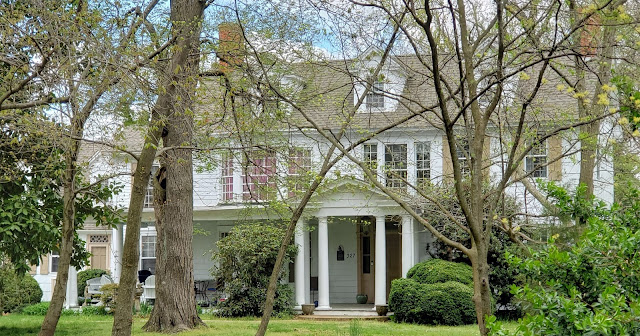Milton: Exploring Its Early Architectural Gems
 |
| Hazzard House in Milton |
Milton has too many things to see to cover in one blog post! My last blog post focused on its delightful Victorian architecture. Here I’ll cover some of its earlier buildings.
Milton was founded in 1686, when James Gray “patented” 100 acres at the navigable head of the Broadkill River. He named the town Milton after the English poet John Milton, who had died a few years earlier. I don’t think much more happened until the mid-1700s, when George Conwell and William Perry owned the land—Conwell on the north side of the Broadkill River and Perry on the south side. They laid the land out in lots that they sold. By the late 1700s, Milford was a small village, with mills and ports for lumber and agricultural products.
Probably the oldest house we saw was Hazzard House, also known as Governor David Hazzard Mansion and Governor’s Bed & Breakfast at 327 Union St. It’s pictured above. Its “core” was built around 1790 by Governor Hazzard’s father, with additions in the early 1800s. Hazzard was one of five governors from Milton.
We saw four other houses from the early 1800s that are similar to each other. The original part of Lank-Shivelhood House at 301 Walnut Street was built around 1800 and expanded around 1830. John Lank was a sea captain.
 |
| Lank Shivelson House in Milton |
The original house at 115 Chestnut Street was built before 1812.
 |
| 115 Chestnut Street in Milton |
Another house from the early 1800s is R. L. Lacy House at 412 Federal Street, built around 1820.
 |
| R. L. Lacy House in Milton |
Draper-Adkins House at 204 Federal Street was built around 1840.
 |
| Draper-Adkins House in Milton |
One thing all four houses share is front additions. The double windows in the large front addition and dormer at 115 Chestnut Street suggest to me that they may have been added in the early 20th century. The other houses’ front porches and balconies have Victorian trim that was popular on Gothic Revival houses in the mid-1800s. Something we’ve seen over and over on the Delaware Bayshore Byway is early 1800s houses updated later in the 1800s in the latest Victorian styles.
The other thing all four houses share is the design of the original houses. They’re all simple and symmetrical. Notice that the original house at 115 Chestnut Street was probably only one room deep. The first floor was probably just two rooms separated by a center hall. This was a popular house layout in Milton’s early years.
I read that many early Milton homes have summer kitchens in their backyards, connected to the main houses by breezeways called “dogtrots.” Unfortunately, we couldn’t see any from the street.
We saw one other pre-Civil War house: W. C. Prettyman House at 203 Federal Street, built around 1845.
 |
| W. C. Prettyman House in Milton |
W. C. Prettyman House is very different from the earlier Milton houses we saw. It’s a great example of Greek Revival architectural style, which I discuss in a blog post on Delaware City.
We saw one other interesting pre-Civil War building: Lydia B. Cannon Museum at 210 Union Street. It was built in 1857 as the Methodist Protestant Church. The bell tower and stained glass windows were added in 1906. It’s listed on Google Maps as Milton Historical Society.
 |
| Milton Historical Society |




Great post.
ReplyDeleteI wonder why the assembly chose to name Milton for the poet.
According to a 2008 article in The News Journal, "No one knows just what it was about a 17th century English poet-philosopher that made him such a hit in Delaware."
Residents asked the general assembly to change the town's name in February 1807, but Melinda Huff, director of the Milton Historical Society in 2008 said no one knows why.
No documentation regarding the choice of the name has been found. The very first mention in print of a link between the town's name and the poet appeared in 81 years later.
The uncertainty didn't deter the townspeople from erecting a statue of Milton in 2010: https://tinyurl.com/aaehtb7m
PS: Milton never visited America, except in fiction: https://tinyurl.com/zph8eksa
DeleteThat's really interesting! What a mystery! I first assumed the name came from being a "Mill Town" until I read that it was named for John Milton.
Delete